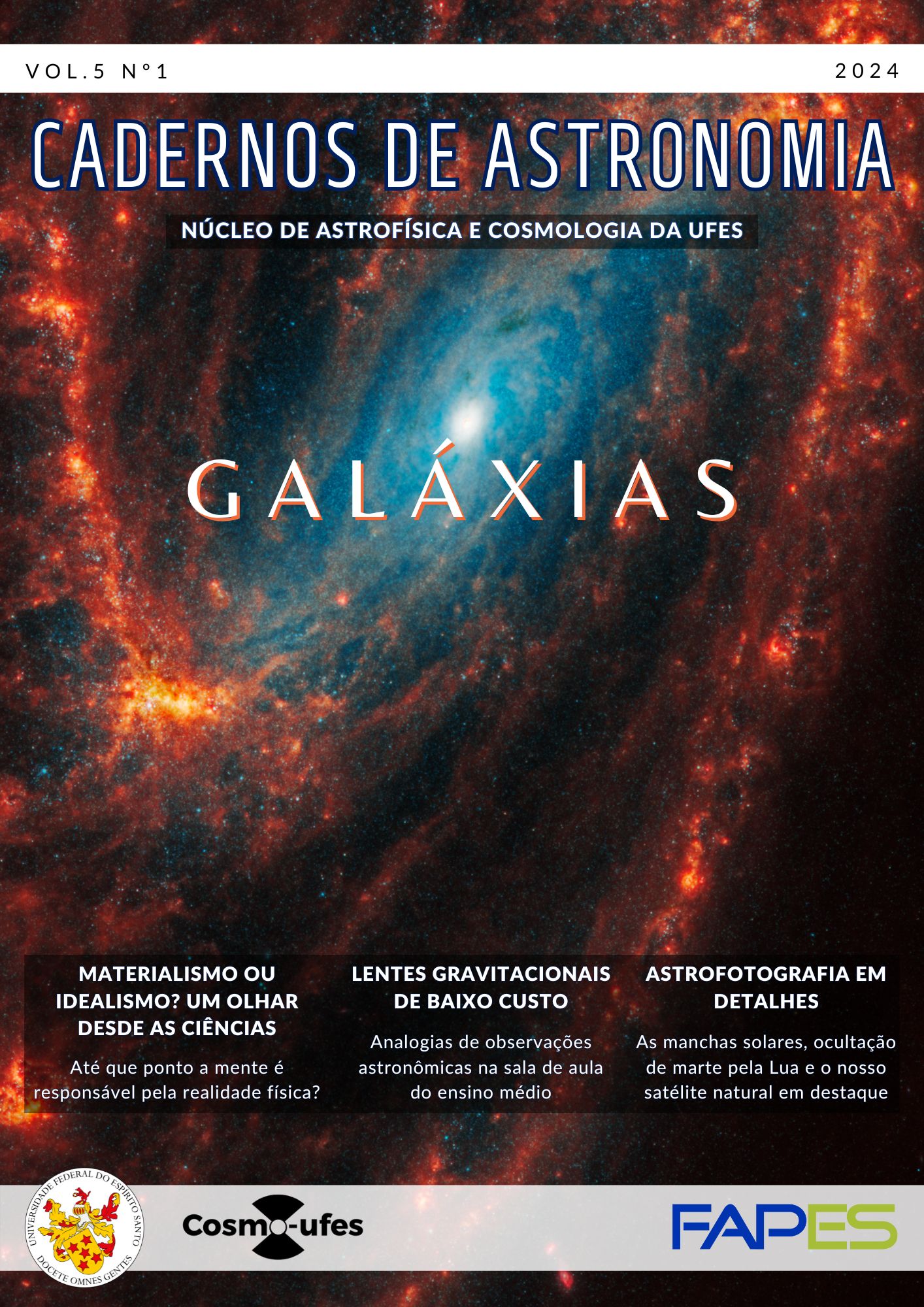Núcleos ativos de galáxias: uma breve introdução
DOI:
https://doi.org/10.47456/Cad.Astro.v5n1.43653Palavras-chave:
núcleos ativos de galáxias, galáxias ativas, galáxias SeyfertsResumo
Núcleo ativos de galáxia (AGN) são caracterizadas pela presença de buracos-negros supermassivos (SMBHs) em seus núcleos, os quais estão envolvidos na aquisição de matéria por meio de um disco de acreção. No paradigma dos AGNs, persiste um debate significativo quanto à origem dessa atividade, abrangendo desde os mecanismos desencadeadores até os impactos sobre a poeira e as moléculas nas galáxias hospedeiras. Este trabalho busca descrever as principais características observacionais da classificação e unificação sobre núcleo ativos de galáxias, onde também podem ser visto na literatura como apenas galáxias ativas.
Referências
[1] C. Tadhunter, An introduction to active galactic nuclei: classification and unification, New Astronomy Reviews 52(6), 227 (2008).
[2] E. D. d. Santos et al., O caminho tortuoso de mulheres na ciência e na astronomia: evoulção e composição estelar a partir de estudos feitos por Cecilia Payne, Revista Vitruvian Cogitationes 4(extra), 246 (2023).
[3] P. C. Vieira, N. T. Massoni e A. Alves-Brito,
O papel de Cecilia Payne na determinação da composição estelar, Revista Brasileira de Ensino de Física 43 (2021).
[4] R. Antonucci, Unified models for active galactic nuclei and quasars., Annual Review of Astronomy and Astrophysics 31(1), 473 (1993).
[5] B. M. Peterson, An introduction to active galactic nuclei (Cambridge University Press, Cambridge, 1997).
[6] J. H. Krolik, Active galactic nuclei: from the central black hole to the galactic environment (Princeton University Press, Princeton, 1998).
[7] D. E. Osterbrock e G. J. Ferland, Astrophysics of gaseous nebulae and active galactic nuclei (University Science Books, Melville, 2006).
[8] L. C. Ho, Nuclear activity in nearby galaxies., Annual Review of Astronomy and Astrophysics 46, 475 (2008). ArXiv:0803. 2268.
[9] H. Netzer, Revisiting the unified model of active galactic nuclei, Annual Review of Astronomy and Astrophysics 53(1), 365 (2015).
[10] T. M. Heckman e P. N. Best, The coevolution of galaxies and supermassive black holes: insights from surveys of the contemporary universe, Annual Review of Astronomy and Astrophysics 52, 589 (2014).
[11] W. N. Brandt e D. M. Alexander, Supermassive black-hole growth over cosmic time: Active galaxy demography, physics, and ecology from Chandra surveys, Proceedings of the National Academy of Sciences 107(16), 7184 (2010).
[12] R. R. J. Antonucci e J. S. Miller, Spectropolarimetry and the nature of NGC 1068, The Astrophysical Journal 297, 621 (1985).
[13] R. Terlevich e J. Melnick, Warmers: the missing link between starburst and Seyfert galaxies, Monthly Notices of the Royal Astronomical Society 213(4), 841 (1985).
[14] A. Alonso-Herrero et al., Nuclear 11.3 μm PAH emission in local active galactic nuclei, Monthly Notices of the Royal Astronomical Society 443(3), 2766 (2014).
[15] A. Alonso-Herrero et al., A mid-infrared spectroscopic atlas of local active galactic nuclei on sub-arcsecond resolution using GTC/CanariCam, Monthly Notices of the Royal Astronomical Society 455(1), 563 (2016).
[16] C. M. Canelo et al., Profile comparison of the 6-9 μm polycyclic aromatic hydrocarbon bands in starburst-dominated galaxies, Monthly Notices of the Royal Astronomical Society 507(4), 6177 (2021).
[17] C. M. Canelo et al., Variations in the 6.2 μm emission profile in starburst-dominated galaxies: a signature of polycyclic aromatic nitrogen heterocycles (PANHs)?, Monthly Notices of the Royal Astronomical Society 475, 3746 (2018).
[18] C. M. Canelo, O mundo aromático dos PAHs no meio interestelar às condições bióticas, Dissertação de Mestrado, IAG, São Paulo (2016).
[19] M. G. Pastoriza, Studies of galaxies with peculiar nuclei, Astrophysics and Space Science 33(1), 173 (1975).
[20] R. A. Riffel et al., Mapping of molecular gas inflow towards the Seyfert nucleus of NGC 4051 using Gemini NIFS, Monthly Notices of the Royal Astronomical Society 385(3), 1129 (2008).
[21] R. Riffel, A. Rodriguez-Ardila e M. G. Pastoriza, A 0.8-2.4 μm spectral atlas of active galactic nuclei, Astronomy & Astrophysics 457(1), 61 (2006).
[22] E. A. Fath, The spectra of some spiral nebulae and globular star clusters, Lick Observatory Bulletins 5(149), 71 (1909).
[23] E. Y. Khachikian e D. W. Weedman, An atlas of Seyfert galaxies, ApJ 192, 581 (1974).
[24] D. E. Osterbrock, Observational model of the ionized gas in Seyfert and radio-galaxy nuclei, Proceedings of the National Academy of Sciences 75(2), 540 (1978).
[25] J. Runco, Frequency of Seyfert type transitions in a sample of 102 local active galactic nuclei, Trabalho de Conclusão de Curso, California Polytechnic State University (2015). Disponível em https://digitalcommons.calpoly.edu/physsp/128/, acesso em fev. 2024.
[26] M. Schmidt, 3C 273: a star-like object with large redshift, Nature 197, 1040 (1963).
[27] J. L. Greenstein, Redshift of the unusual radio source: 3C 48, Nature 197, 1041 (1963).
[28] T. M. Heckman, An optical and radio survey of the nuclei of bright galaxies - activity in the normal galactic nuclei, Astronomy & Astrophysics 87, 152 (1980).
[29] M. Berton et al., An orientation-based unification of young jetted AGN: the case of 3C 286, Frontiers in Astronomy Space Sciences 4 (2017).
[30] D. A. Sales et al., An embedded active nucleus in the OH Megamaser Galaxy IRAS16399-0937, The Astrophysical Journal 799(1), 25 (2015).
[31] R. D. Blandford e M. J. Rees, Some comments on radiation mechanisms in Lacertids, in Pittsburgh Conference on BL Lac Objects, Proceedings, editado por A. M. Wolfe (1978), 328–341.
Downloads
Publicado
Versões
- 16-03-2024 (2)
- 15-03-2024 (1)
Edição
Seção
Licença
Copyright (c) 2024 Dinalva Aires de Sales

Este trabalho está licenciado sob uma licença Creative Commons Attribution 4.0 International License.






